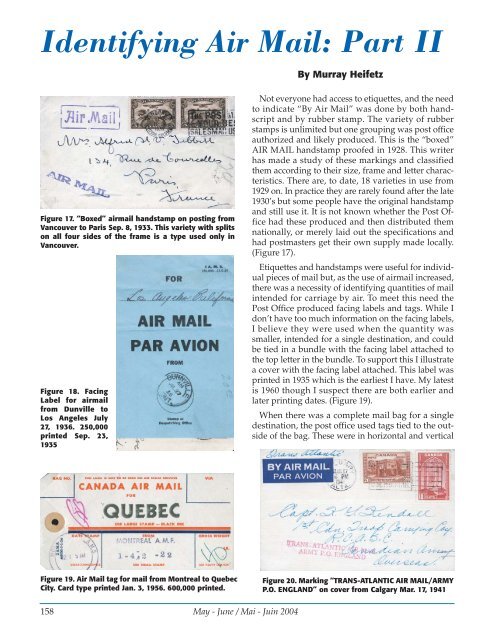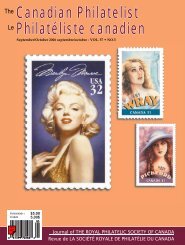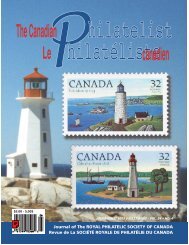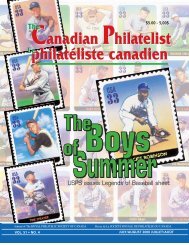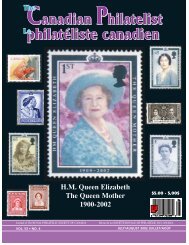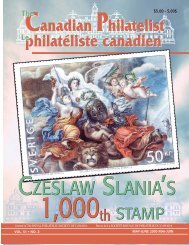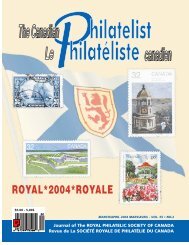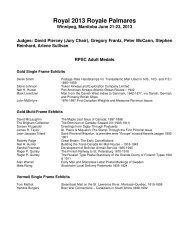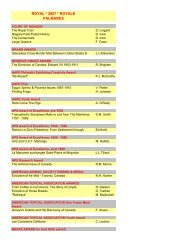TCP-M/J 04 - The Royal Philatelic Society of Canada
TCP-M/J 04 - The Royal Philatelic Society of Canada
TCP-M/J 04 - The Royal Philatelic Society of Canada
Create successful ePaper yourself
Turn your PDF publications into a flip-book with our unique Google optimized e-Paper software.
Identifying Air Mail: Part II<br />
By Murray Heifetz<br />
Figure 17. “Boxed” airmail handstamp on posting from<br />
Vancouver to Paris Sep. 8, 1933. This variety with splits<br />
on all four sides <strong>of</strong> the frame is a type used only in<br />
Vancouver.<br />
Figure 18. Facing<br />
Label for airmail<br />
from Dunville to<br />
Los Angeles July<br />
27, 1936. 250,000<br />
printed Sep. 23,<br />
1935<br />
Not everyone had access to etiquettes, and the need<br />
to indicate “By Air Mail” was done by both handscript<br />
and by rubber stamp. <strong>The</strong> variety <strong>of</strong> rubber<br />
stamps is unlimited but one grouping was post <strong>of</strong>fice<br />
authorized and likely produced. This is the “boxed”<br />
AIR MAIL handstamp pro<strong>of</strong>ed in 1928. This writer<br />
has made a study <strong>of</strong> these markings and classified<br />
them according to their size, frame and letter characteristics.<br />
<strong>The</strong>re are, to date, 18 varieties in use from<br />
1929 on. In practice they are rarely found after the late<br />
1930’s but some people have the original handstamp<br />
and still use it. It is not known whether the Post Office<br />
had these produced and then distributed them<br />
nationally, or merely laid out the specifications and<br />
had postmasters get their own supply made locally.<br />
(Figure 17).<br />
Etiquettes and handstamps were useful for individual<br />
pieces <strong>of</strong> mail but, as the use <strong>of</strong> airmail increased,<br />
there was a necessity <strong>of</strong> identifying quantities <strong>of</strong> mail<br />
intended for carriage by air. To meet this need the<br />
Post Office produced facing labels and tags. While I<br />
don’t have too much information on the facing labels,<br />
I believe they were used when the quantity was<br />
smaller, intended for a single destination, and could<br />
be tied in a bundle with the facing label attached to<br />
the top letter in the bundle. To support this I illustrate<br />
a cover with the facing label attached. This label was<br />
printed in 1935 which is the earliest I have. My latest<br />
is 1960 though I suspect there are both earlier and<br />
later printing dates. (Figure 19).<br />
When there was a complete mail bag for a single<br />
destination, the post <strong>of</strong>fice used tags tied to the outside<br />
<strong>of</strong> the bag. <strong>The</strong>se were in horizontal and vertical<br />
Figure 19. Air Mail tag for mail from Montreal to Quebec<br />
City. Card type printed Jan. 3, 1956. 600,000 printed.<br />
Figure 20. Marking “TRANS-ATLANTIC AIR MAIL/ARMY<br />
P.O. ENGLAND” on cover from Calgary Mar. 17, 1941<br />
158 May - June / Mai - Juin 20<strong>04</strong>


